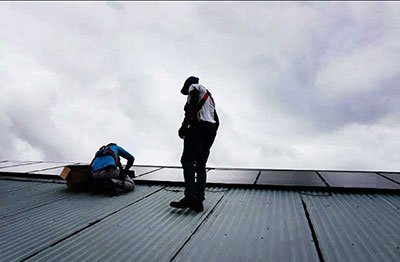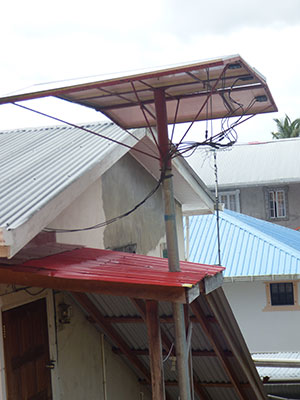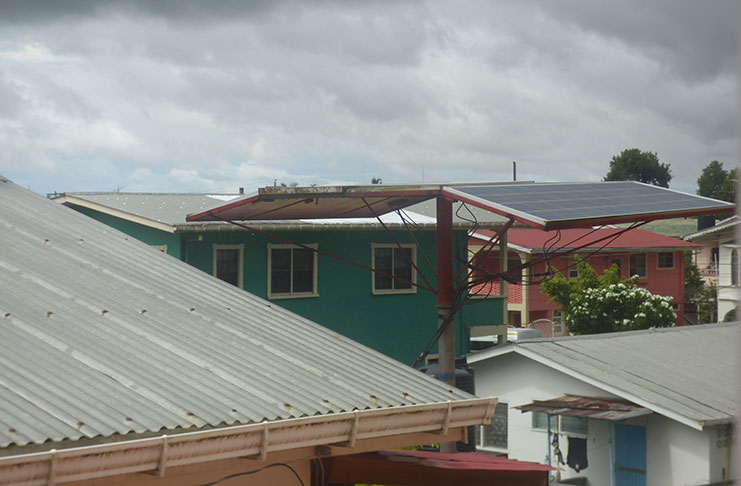– solar source gaining momentum
By Ravena Gildharie
WITH the price of fossil fuels steadily rising, more nations are turning to renewable sources

on a school
of energy. Countries such as Sweden, Germany and China are leading with investments and outcomes, but for developing economies like Guyana, it’s a daunting task. Nevertheless, the direction remains firm in pursuance of a ‘green’ state and more notably, the private sector and citizens are rapidly pursuing self-generation of power, using renewable energy, particularly solar systems.
Businesses such as Demerara Bank Limited (DBL), Starr Computers, Nand Persaud Incorporated and Texila American University have embraced the notion of ‘green’ energy to reduce dependency on petroleum-based fuels, and ensure reliable power supplies for their operations.
At the governmental level, resources are channelled to power state-owned buildings, such as schools and hospitals, with alternative sources of energy mainly solar photovoltaics (PV) systems in hinterland and riverian areas. These are also becoming increasingly popular among citizens for use at private residences.

across the country
Chief Executive Officer of the Institute of Private Enterprise Development (IPED) Ramesh Persaud, told the Pepperpot Magazine that renewable energy, particularly solar systems, is gaining momentum in Guyana.
“We have seen an increase in the number of loan enquiries from small businesses for financing in this regard and have actually provided loan funds for a few businesses in the hinterland to assist with solar installation,” he revealed.
Further, the lending institution is considering the use of solar technologies for its own use, as part of plans for new buildings and rehabilitation of existing facilities.
“We are exploring the possibility of “greening” all our operations countrywide in the medium term,” Persaud stated.
Historically, Guyana has depended on imported petroleum-based fuels as its primary source of energy. According to the Guyana Energy Agency (GEA), the country imported 4.9 million barrels of petroleum-based products in 2014 which equated to 13,531 barrels per day. This consisted of diesel (gasoil), fuel oil, gasoline (mogas), avjet, avgas, kerosene and liquefied petroleum gas (LPG).

“The volumes imported in 2014 represented a 4.14 percent increase when compared to 2013. Petroleum imports for 2013 were acquired at a cost, insurance and freight (CIF) value of approximately US$5 62 million (31.6 percent of total imports) and accounted for about 21 percent of the country’s gross domestic product (GDP),” stated GEA’s 2016-2020 Strategic Plan.
The power sector accounted for about 36 percent of petroleum imports in 2014 with electricity generated mainly from the Guyana Power and Light Company (GPL) and several small generation facilities countrywide, GEA has stated.
Outlined in its 2016-2020 Strategic Plan, GEA is hoping that Guyana would install more than 13 megawatts of solar Photovoltaic systems within the next five years.
“While still relatively expensive when compared to the cost of energy supplied by the grid, solar photovoltaic prices are decreasing and their use will be encouraged, provided the prices remain sustainable,” the agency outlined. It continues to encourage Importation and installation of solar water heaters for both residential and commercial use.
Growing demand for solar system
The Farfan and Mendes Group is one of the largest retail suppliers of solar equipment alongside other companies as Gafoors, A. Ally and Sons, Eagle Resources Limited and Jerome Defreitas and Sons Limited.
Farfan’s Manager for Alternative Energy,Martin Carto, told the Pepperpot Magazine that previously most of the company’s solar system customers were from hinterland and rural areas, but recently it has grown across the coastland, where interest is increasing in renewable sources of energy.
“We provide the best technical advice and options to customers for alternative energy. We have been in the business of solar systems for over 15 years when we were serving mostly the hinterland. We actually pioneered the grid-tie system, and we have been pushing the advancement of technology in Guyana by introducing cutting-edge technology,” Carto outlined.
The growing interest in alternative energy has led the company to expand investments, as there is now a specially designed solar workshop at the Providence location outfitted with a well-equipped service centre that includes an authorised inverter company. Farfan works with each customer to combine and install a solar system that best matches the client’s needs. It also assists customers to get the necessary approval from the Guyana Power and Light (GPL) company and work through other problems facing the customers before, during and even after installation of the solar system.
Carto observed that the prices for solar equipment have decreased significantly in recent years, making it affordable for more customers. Panels can be purchased for as low as $40, 000, but the total cost to install an entire solar system varies, as this would be based on the individual client’s demands and choices.
To date, the company has installed a total of two megawatts of solar systems and continues to do more. The company is currently working on a project in Kato, Region Eight. It is one of the companies that bid for government projects, and has won some contracts to install solar systems at various locations. However, Carto said there is an unlevel playing field when bidding for such projects, as the foreign companies are exempted from the two percent withholding tax imposed on local bidders.
Just last June, the government announced that a German Company, Meeco Services Deutschland GmbH, had been awarded a $35.3 million contract to supply and install grid-connected solar photovoltaic systems on 57 government buildings in Guyana. A grid-connected photovoltaic power system – or grid-connected PV power system – is an electricity-generating solar PV power system that is connected to the utility grid. GEA is the procuring entity and had been implementing the country’s move toward ‘green’ energy.
Earlier this year, the GEA installed nine grid-connected solar photovoltaic (PV) systems at public Institutions countrywide, mainly secondary schools, to produce an estimated 124,321 kWh of energy annually. These included secondary schools at Diamond, Hope, Leguan and Leonora, as well as the Ministry of Indigenous People’s Affairs Scholarship Hostel. The project was done at a cost of about $48 million and according to the GEA, it aids in the avoidance of 87,025 kg of carbon dioxide emissions and will result in savings of approximately $8,336,330 annually with a simple payback period of about 5.8 years.
Joint venture and private investors
The Agency also provides technical support to the Latin American Energy Organization (OLADE) Energy Project, which seeks to implement pilot/demonstration sustainable energy initiatives in three rural communities in Guyana. These are Shulinab in Region Nine, Powaikoru in Region One and Moraikobai in Region Five. The Canadian government is funding the initiative, titled ‘Corporate Social Responsibility Renewable Energy Project.’
Aside from the state-implemented initiative, the private sector is also fuelling the drive toward solar energy. DBL’s Head Office on Camp Street is fully powered by a solar off-grid system built with a capacity of 125KW that supports the 25,000 square-foot building and carries 52 inverter-based air condition units and 200 LED lights, powered by 360 solar panels. The system was installed with 416 batteries as back-up in the absence of sunlight.
Previously, DBL’s Chief Executive Officer Pravinchandra Dave said the perception that installing solar energy is expensive, is a myth. He encouraged technical feasibility and commercial viability to be done by companies considering a shift to solar power. DBL spent $28 million to install the solar system which would yield some savings for the company, as of were connected to the national grid.
Starr Computer, which previously sold solar equipment, enjoys 60 percent of its power generation from solar systems, installed several years ago. Further, the company continues to promote the use of renewable energy, and according to Sales and Marketing Manager Penny Francis, Starr hosts regular education seminars on renewable energy for students and others. The sessions include both classroom- style teaching and site visits to the company’s solar system.
Other investors are piloting various initiatives to push renewable energy such as Green Heart Tree Energy (GHTE), which entered Guyana’s renewable energy market last March when it commissioned a 10-kilowatt system to power the Paramakatoi Flavours Sun-Dried Tomato Processing Plant.
GHTE said it took the initiative to design, engineer, procure, construct and deliver a non-grid connected solar PV micro-grid system for the Paramakatoi Flavours Sun-Dried Tomato Plant. The design took into account the actual climatic data and historical weather patterns of the area.



.jpg)








